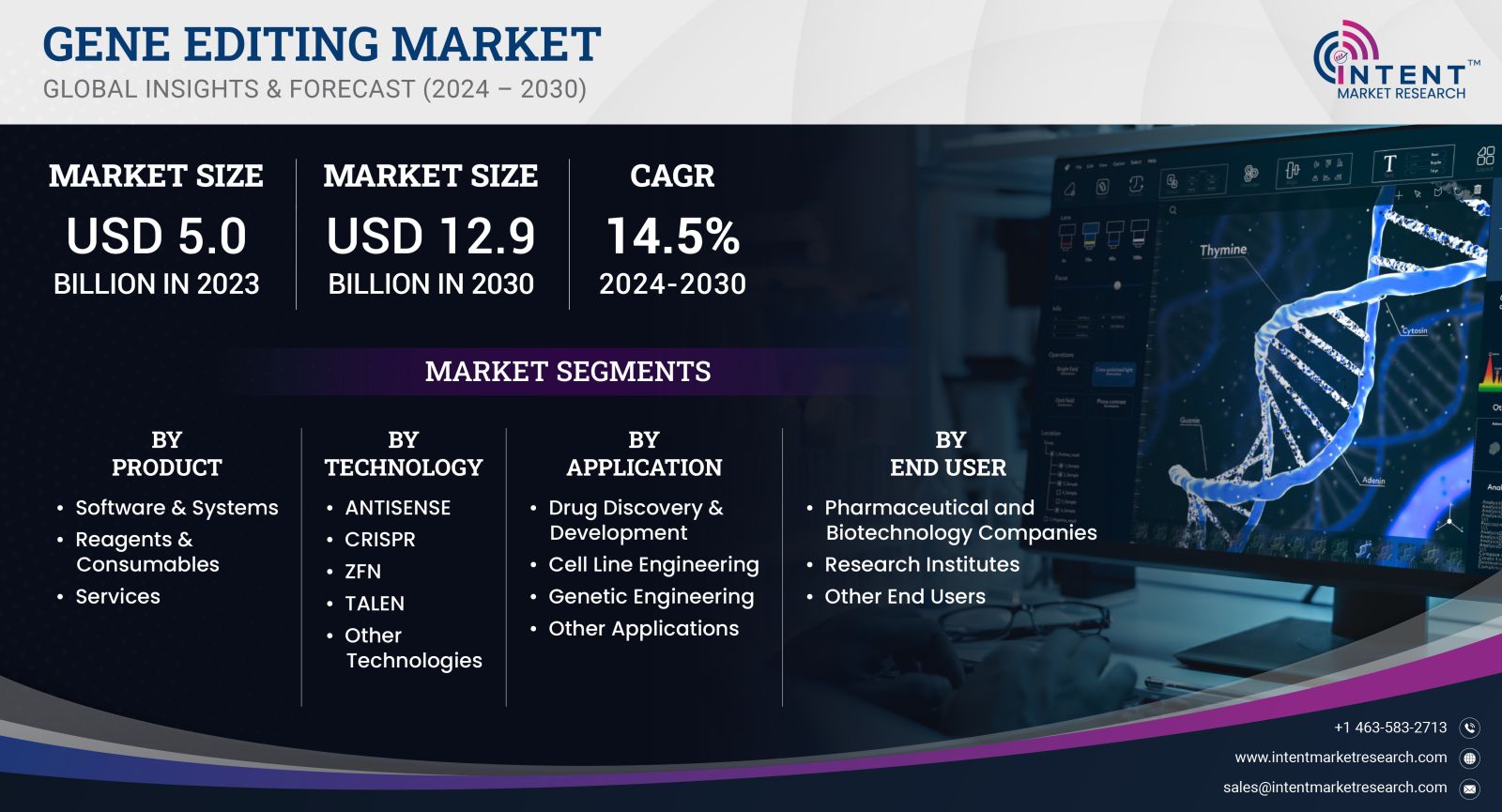As per Intent Market Research, the Gene Editing Market was estimated at USD 5.0 billion in 2023-e and will surpass USD 12.9 billion by 2030; growing at a CAGR of 14.5% during 2024 - 2030.
The report focuses on estimating the current market potential in terms of the total addressable market for all the segments, sub-segments, and regions. In the process, all the high-growth and upcoming technologies were identified and analyzed to measure their impact on the current and future market. The report also identifies the key stakeholders, their business gaps, and their purchasing behavior. This information is essential for developing effective marketing strategies and creating products or services that meet the needs of the target market. The report also covers a detailed analysis of the competitive landscape which includes major players, their recent developments, growth strategies, product benchmarking, and manufacturing operations among others. Also, brief insights on start-up ecosystem and emerging companies is also included as part of this report.

Report Objectives:
The report will help you answer some of the most critical questions in the Gene Editing Market. A few of them are as follows:
- What are the key drivers, restraints, opportunities, and challenges influencing the market growth?
- What are the prevailing technology trends in the gene editing market?
- What is the size of the gene editing market based on segments, sub-segments, and regions?
- What is the size of different market segments across key regions: North America, Europe, Asia Pacific, Middle East, and Rest of the World?
- What are the market opportunities for stakeholders after analyzing key market trends?
- Who are the leading market players and what are their market share and core competencies?
- What is the degree of competition in the market and what are the key growth strategies adopted by leading players?
- What is the competitive landscape of the market, including market share analysis, revenue analysis, and a ranking of key players?
Report Scope:
|
Report Features |
Description |
|
Market Size (2023-e) |
USD 5.0 billion |
|
Forecasted Value (2030) |
USD 12.9 billion |
|
CAGR (2024-2030) |
14.5% |
|
Base Year for Estimation |
2023-e |
|
Historic Year |
2022 |
|
Forecast Period |
2024-2030 |
|
Report Coverage |
Market Forecast, Market Dynamics, Competitive Landscape, Recent Developments |
|
Segments Covered |
Gene Editing Market By Product (Systems, Software, Consumables, Reagents), By Technology (TALEN, ZFN, CRISPR, Antisense), By Application (Genetic Engineering, Cell Line Engineering, Drug Discovery), By End Use (Pharma & Biotech, Research Institutes) |
|
Regional Analysis |
North America (US, Canada), Europe (Germany, France, UK, Spain, Italy & Rest of Europe), Asia Pacific (China, Japan, South Korea, India, and rest of Asia Pacific), Latin America (Brazil, Mexico, Argentina, & Rest of Latin America), Middle East & Africa (Saudi Arabia, South Africa, Turkey, United Arab Emirates, & Rest of MEA) |
|
Customization Scope |
Customization for segments, region/country-level will be provided. Moreover, additional customization can be done based on the requirements |
|
1. Introduction |
|
1.1.Market Definition |
|
1.2.Scope of the Study |
|
1.3.Research Assumptions |
|
1.4.Study Limitations |
|
2. Research Methodology |
|
2.1.Research Approach |
|
2.1.1.Top-Down Method |
|
2.1.2.Bottom-Up Method |
|
2.1.3.Factor Impact Analysis |
|
2.2.Insights & Data Collection Process |
|
2.2.1.Secondary Research |
|
2.2.2.Primary Research |
|
2.3.Data Mining Process |
|
2.3.1.Data Analysis |
|
2.3.2.Data Validation and Revalidation |
|
2.3.3.Data Triangulation |
|
3. Executive Summary |
|
3.1.Major Markets & Segments |
|
3.2.Highest Growing Regions and Respective Countries |
|
3.3.Impact of Growth Drivers & Inhibitors |
|
3.4.Regulatory Overview by Country |
|
4. Gene Editing Market, by Product (Market Size & Forecast: USD Billion, 2024 – 2030) |
|
4.1.Software & Systems |
|
4.2.Reagents & Consumables |
|
4.3.Services |
|
5. Gene Editing Market, by Technology (Market Size & Forecast: USD Billion, 2024 – 2030) |
|
5.1.ANTISENSE |
|
5.2.CRISPR |
|
5.3.ZFN |
|
5.4.TALEN |
|
5.5.Other technologies |
|
6. Gene Editing Market, by Application (Market Size & Forecast: USD Billion, 2024 – 2030) |
|
6.1.Drug Discovery & Development |
|
6.2.Cell Line Engineering |
|
6.3.Genetic Engineering |
|
6.4.Other Applications |
|
7. Gene Editing Market, by End User (Market Size & Forecast: USD Billion, 2024 – 2030) |
|
7.1.Pharmaceutical and Biotechnology Companies |
|
7.2.Research Institutes |
|
7.3.Other End Users |
|
8. Regional Analysis |
|
8.1.Regional Overview |
|
8.2.North America |
|
8.2.1.Regional Trends & Growth Drivers |
|
8.2.2.Barriers & Challenges |
|
8.2.3.Opportunities |
|
8.2.4.Factor Impact Analysis |
|
8.2.5.Technology Trends |
|
8.2.6.North America Gene Editing Market, by Product & Service |
|
8.2.7.North America Gene Editing Market, by Technology |
|
8.2.8.North America Gene Editing Market, by End User |
|
8.2.9.North America Gene Editing Market, by Application |
|
*Similar segmentation will be provided at each regional level |
|
8.3.By Country |
|
8.3.1.US |
|
8.3.1.1.US Gene Editing Market, by Product & Service |
|
8.3.1.2.US Gene Editing Market, by Technology |
|
8.3.1.3.US Gene Editing Market, by End User |
|
8.3.1.4.US Gene Editing Market, by Application |
|
8.3.2.Canada |
|
*Similar segmentation will be provided at each country level |
|
8.4.Europe |
|
8.5.APAC |
|
8.6. Latin America |
|
8.7. Middle East and Africa |
|
9. Competitive Landscape |
|
9.1.Overview of the Key Players |
|
9.2.Competitive Ecosystem |
|
9.2.1.Platform Manufacturers |
|
9.2.2.Subsystem Manufacturers |
|
9.2.3.Service Providers |
|
9.2.4.Software Providers |
|
9.3.Company Share Analysis |
|
9.4.Company Benchmarking Matrix |
|
9.4.1.Strategic Overview |
|
9.4.2.Product Innovations |
|
9.5.Start-up Ecosystem |
|
9.6.Strategic Competitive Insights/ Customer Imperatives |
|
9.7.ESG Matrix/ Sustainability Matrix |
|
9.8.Manufacturing Network |
|
9.8.1.Locations |
|
9.8.2.Supply Chain and Logistics |
|
9.8.3.Product Flexibility/Customization |
|
9.8.4.Digital Transformation and Connectivity |
|
9.8.5.Environmental and Regulatory Compliance |
|
9.9.Technology Readiness Level Matrix |
|
9.10.Technology Maturity Curve |
|
9.11.Buying Criteria |
|
10.Company Profiles |
|
10.1.Merck |
|
10.1.1.Company Overview |
|
10.1.2.Company Financials |
|
10.1.3.Product/Service Portfolio |
|
10.1.4.Recent Developments |
|
10.1.5.IMR Analysis |
|
*Similar information will be provided for other companies |
|
10.2.Thermo Fisher Scientific |
|
10.3.GenScript |
|
10.4.Tecan Life Sciences |
|
10.5.Agilent Technologies |
|
10.6.PerkinElmer 10.7.Lonza 10.8.Sangamo Therapeutics 10.9.Bluebird Bio 10.10.Creative Biogene |
|
11.Appendix |
A comprehensive market research approach was employed to gather and analyze data on the Gene Editing Market. In the process, the analysis was also done to estimate the parent market and relevant adjacencies to major the impact of them on the gene editing Market. The research methodology encompassed both secondary and primary research techniques, ensuring the accuracy and credibility of the findings.
.jpg)
Secondary Research
Secondary research involved a thorough review of pertinent industry reports, journals, articles, and publications. Additionally, annual reports, press releases, and investor presentations of industry players were scrutinized to gain insights into their market positioning and strategies.
Primary Research
Primary research involved conducting in-depth interviews with industry experts, stakeholders, and market participants across the gene editing ecosystem. The primary research objectives included:
- Validating findings and assumptions derived from secondary research
- Gathering qualitative and quantitative data on market trends, drivers, and challenges
- Understanding the demand-side dynamics, encompassing end-users, component manufacturers, facility providers, and service providers
- Assessing the supply-side landscape, including technological advancements and recent developments
Market Size Estimation
A combination of top-down and bottom-up approaches was utilized to estimate the overall size of the gene editing market. These methods were also employed to estimate the size of various subsegments within the market. The market size estimation methodology encompassed the following steps:
- Identification of key industry players and relevant revenues through extensive secondary research
- Determination of the industry's supply chain and market size, in terms of value, through primary and secondary research processes
- Calculation of percentage shares, splits, and breakdowns using secondary sources and verification through primary sources
.jpg)
Data Triangulation
To ensure the accuracy and reliability of the market size estimates, data triangulation was implemented. This involved cross-referencing data from various sources, including demand and supply side factors, market trends, and expert opinions. Additionally, top-down and bottom-up approaches were employed to validate the market size estimates.
NA
